The all think of Tribe of the The Acehnese, aceh, acheh, atjeh, etc.
I. Acehnese Tribe
The Acehnese (Acehnese: Ureuëng Acèh) is the name of an indigenous tribe that inhabits coastal areas and parts of the interior of Aceh Province, Indonesia. The majority of Acehnese tribes are Muslims. The Aceh tribe has several other names namely Lam Muri, Lambri, Akhir, Achin, Asji, A-tse and Atse. The spoken language is the Acehnese language, which is part of the West Malayo-Polynesian family and closely related to the Cham languages spoken in Vietnam and Cambodia. The Aceh tribe is actually the descendant of various tribes, people, and nations who live in the land of Aceh. The binding of the unity of Acehnese tribal cultures is mainly in the language, religion and customs of Aceh.
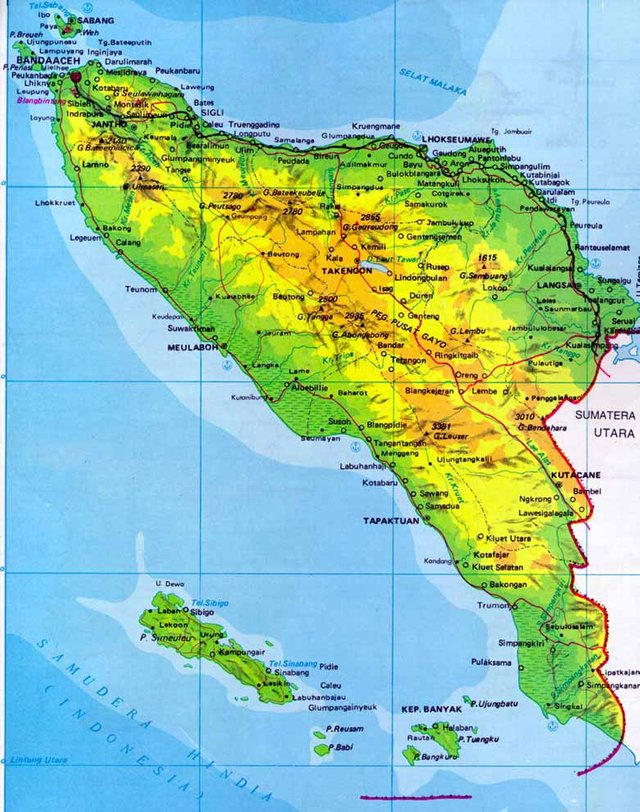
Based on recent estimates, the number of Acehnese tribes reached 3,526,000 people, most of whom reside in Aceh province, Indonesia. Meanwhile, according to the processed data of the 2010 BPS census by Aris Ananta et al., The number of Aceh tribes in Indonesia is 3,404,000. In addition to Indonesia, there are also a considerable diaspora minority in Malaysia, Australia, Canada, United States, and Scandinavian countries.
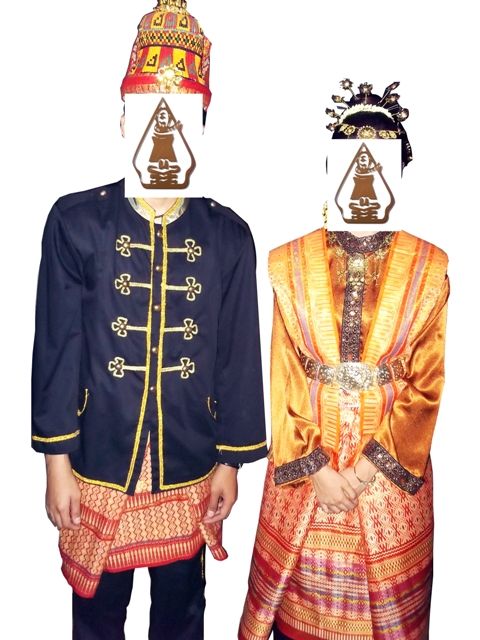
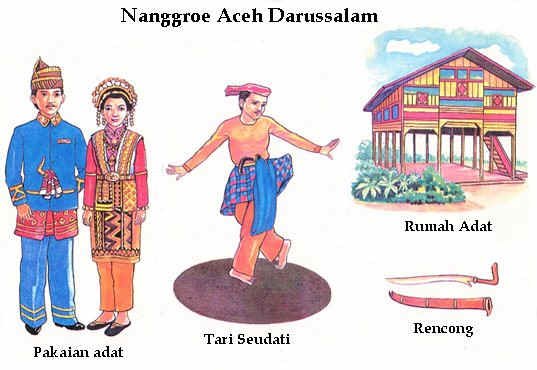
The pre-modern Acehnese tribe lived in a matrilocal and communal way. They live in settlements called gampong. The alliance of the gampong forms a mukim. The golden age of Aceh's culture began in the 16th century, as the glory of the Islamic kingdom of Aceh Darussalam, and then reached its peak in the 17th century. The Aceh tribe is generally known as a holder of Islamic teachings, as well as a militant fighter against the colonial conquests of Portugal and the Netherlands.
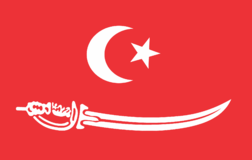
flag of acehnese
II. Of Origin
The earliest archaeological evidence of the inhabitants of Aceh was from the post-Plestosen period, where they lived on the east coast of Aceh (Langsa and Tamiang regions), and showed Australomelanesid features. They mainly live from seafood, especially various types of shellfish, as well as land animals such as pigs and rhinoceros. They had used fire and buried bodies with certain ceremonies. Furthermore, the displacement of indigenous Mantir tribes and Lhan (proto Melayu), as well as the tribes of Champa, Malay, and Minang (deutro Melayu) who came later helped form the indigenous population of Aceh. Foreign nations, especially the south Indian nation, as well as a small number of Arabs, Persians, Turks, and Portuguese are also components of the Aceh tribe. The strategic position of Aceh in the northern part of the island of Sumatra, for thousands of years has become a haven and a mixture of various ethnic groups, namely in the sea trade route from the Middle East to China.
a. Proto and Deutero Malay
The legend of the people of Aceh mentions that the earliest Acehnese came from indigenous tribes; namely the Mante (Mantir) and Lhan (Lanun) tribes. The Mante tribe is a local ethnic group allegedly closely related to the Batak tribe, Gayo tribe and Alas while the Lhan tribe is allegedly still related to the Semang tribe who migrated from the Malay Peninsula or the Rear Indies (Champa, Burma). The Mante tribe initially occupied the area of Great Aceh and then spread to other places. There is also an ethnological suspicion of the Mante ties with the Phoenicians in Babylonia or Dravidian in the Indus and Ganges river valleys, but that can not be determined by the experts of certainty.
When the kingdom of Sriwijaya entered its decline, it is estimated that a group of Malay tribes began to move to the land of Aceh. In the fertile Tamiang river valley they later settled, and came to be known as the Tamiang tribe. After they were conquered by the Samudera Pasai Kingdom (1330), it began their integration into the Acehnese society, although adat and dialect remained close to Malay culture.
The Minang tribe who migrated to Aceh many settled around Meulaboh and Krueng Seunagan valleys. Generally these fertile areas they manage as wet rice fields and pepper gardens, as well as some others also trade. [20] The mixed population of Aceh-Minang is also found in the southern region, in the area around Susoh, Tapaktuan, and Labuhan Haji. Many of them spoke in both Acehnese and Aneuk Jamee languages, their own particular dialects.
Due to the political expansion and diplomatic relations of the Aceh Darussalam Sultanate to the surrounding area, the Acehnese tribe also mixed with the tribes of Alas, Gayo, Karo, Nias, and Kluet. The tribal unity of Acehnese tribesmen who come from various offspring is mainly in the language of Aceh, Islam, and local customs, as formulated by Sultan Iskandar Muda in the Law of Indigenous Makuta Alam.
b. indian
There are also many Indian ancestors in the land of Aceh, who are closely related to the trade and spreading of Hinduism-Buddhism and Islam in the land of Aceh. The Indian people are mostly from Tamil and Gujarat, whose descendants can be found scattered throughout Aceh. The Indian influence is seen, among others, from the cultural and physical appearance of some Acehnese, as well as the variations in Acehnese food that uses a lot of curry. There are also many village names taken from Hindi, (eg Indra Puri), reflecting the heritage of Hindu culture of the past.
c. Arabic, Persian, and Turkish
Arabs who come to Aceh are many who come from Hadramaut, Yemen. Among the immigrants are among the clans of al-Aydrus, al-Habsyi, al-Attas, al-Kathiri, Badjubier, Sungkar, Bawazier, and others, all of which are clans of Arabs from Yemen. They came as scholars of Islam and as traders. The Seunagan area, for example, has so many famous scholars of the Sayyids, whom the local people respected as Teungku Jet or Habib. Similarly, some of the sultan of Aceh is also a descendant of sayyid. Their descendants in the present day are many who have married to the natives of Aceh tribe, and eliminate the name of its surname.
"Sukèë Lhèë Reutōïh ban aneu 'drang
Sukèë Ja Sandang jra haleuba.
Sukèë Ja Batèë na bachut-bachut;
Sukèë Imeum Peuët nyang gō'-gō 'dōnya. "
- Oral poetry (hadih maja) inside De Atjeher, Snouck Hurgronje.
There were also Persian descendants who generally came to spread religion and trade, while the Turks were generally invited to come to become clerics, arms dealers, warrior trainers, and Acehnese royal war soldiers. Currently Persian and Turkish descendants are mostly scattered in the Great Aceh region. [Necessary references] Persian and Turkish heritage names are still used by Acehnese to name their children, even Banda Aceh in the name of Banda Aceh is also an uptake word from Persian (Bandar means "port").
d. Portuguese
The descendants of the Portuguese are primarily in the territory of Kuala Daya, Lam No (the west coast of Aceh). The Portuguese sailors under the command of Captain Pinto, who sailed for Malacca, had stopped and traded in Lam No, where some of them settled there. History records this event occurring between the years 1492-1511, at that time Lam No under the rule of small kingdom Lam No, the leadership of King Meureuhom Daya. Until now, still can be seen offspring of those who still have a profile face of Europe.
III. Culture
a. Language
The Aceh language is included in the Aceh-Chamik language group, a branch of the Malayo-Polynesian family, a branch of the Austronesian language family. The languages closely related to the Acehnese languages are Cham, Roglai, Jarai, Rhade, Chru, Utset and other languages in the Chamik language family, spoken in Cambodia, Vietnam and Hainan. The existence of loan words from the Mon-Khmer language indicates the possibility of the ancestors of the Acehnese tribe dwelling on the Malay Peninsula or southern Thailand bordering the Mon-Khmer speakers, before migrating to Sumatra. The vocabulary of the Acehnese language is enriched by the absorption of Sanskrit and Arabic, especially in the areas of religion, law, government, war, art, and science. For centuries the Acehnese language has also absorbed much of the Malay language. The Malay and Minangkabau languages are the subsequent relatives of the Aceh-Chamik languages, which are equally pertinent in the West Malayo-Polynesian family.
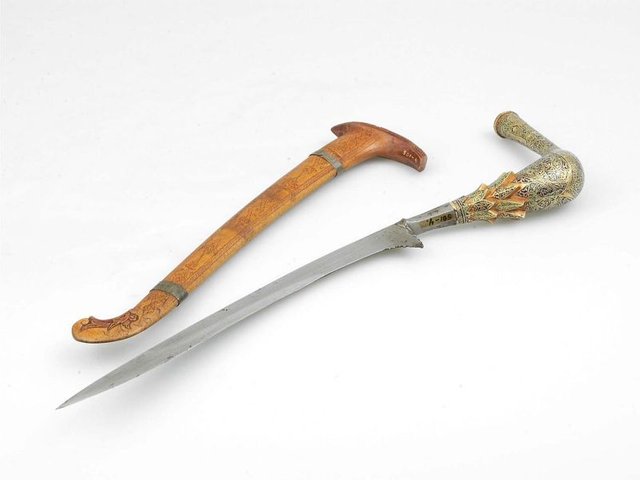
Rencong, the traditional weapon of the Atjeh.
A group of Chamtic-speaking immigrants initially allegedly controlled only a small area, the port of Banda Aceh in Aceh Besar. Marco Polo (1292) states that in Aceh at that time there were 8 small kingdoms, each with its own language. The expansion of power over other coastal kingdoms, especially Pidie, Pasai, and Daya, and the gradual absorption of the population for 400 years, eventually made the language of the Banda Aceh people to be dominant in Aceh's coastal areas. The other native speakers, then also pressed into the interior by the Acehnese speaking speakers who opened the fields.
The Acehnese dialects found in the valleys of Aceh Besar are divided into two major groups, Tunong for dialects in the highlands and Baroh for lowland dialects. The number of dialects contained in Aceh Besar and Daya indicates that they are inhabited more than in other regions. In the Pidie region there is also quite a lot of dialects, although not as much in Aceh Besar or Daya. The dialects east of Pidie and south of Daya are more homogeneous, thus linked to later migration along with the expanding power of the Aceh Kingdom post-1500.
Local Government of Aceh, among others through Governor's Decree No. 430/543/1986 and Bylaw no. 2 of 1990 established the Institute for Indigenous and Cultural Aceh (LAKA), with a mandate to foster the development of customs and customs of customary communities and institutions in Aceh. [39] Indirectly, this institution also keeps the lestarinya Aceh language, because in every activity of custom and culture, the delivery of these activities is in Aceh language. Likewise, Acehnese is commonly used in everyday affairs organized by government agencies in Aceh.
b. Traditional Acehnese dances
Traditional Acehnese dances illustrate local heritage, religion, and folklore. Aceh dances are generally performed in groups, where a group of dancers are of the same gender, and their dancing positions are either standing or sitting. When viewed from the music pengiringnya, dances can be grouped into two kinds; which is accompanied by vocals and percussion of the body of the dancers themselves, and accompanied by ensemble of musical instruments.
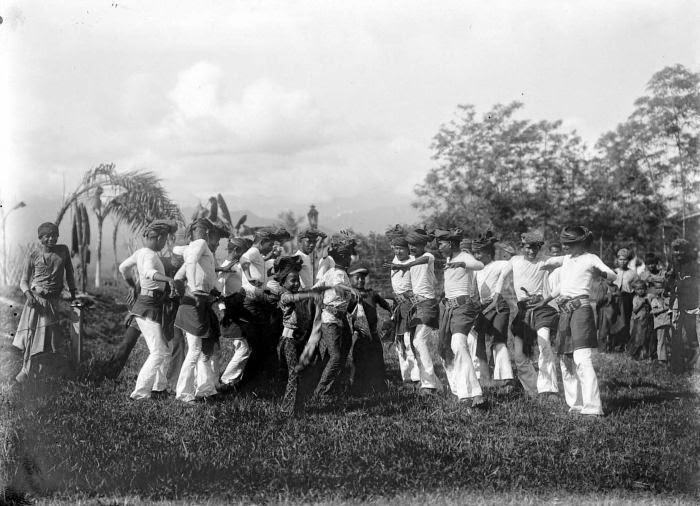
i. Seudati Dance
ii. Rateb Meuseukat Dance
iii. Likok Pulo Dance
iv. Laweut Dance
v. Pho Dance
vi. Ratoh Duek Dance
vii. Tarek Dance Pukat
viii. Rabbani Wahed Dance
ix. Dance Ranup lam Puan
x. Rapa'i Geleng Dance
xi. and so many other
c. Typical food
Aceh's famous cuisine uses many of the spice combinations as commonly found in Indian and Arab cuisines, namely ginger, peppercorn, coriander, cumin, clove, cinnamon, cardamom, and fennel. A variety of Acehnese food is cooked with curry or curry spices and coconut milk, which is generally combined with meat, such as buffalo, cow, goat, fish, and chicken meat. [43] Some traditional recipes have traditionally used cannabis as a flavoring spice; which is also found in some other Southeast Asian cuisines such as in Laos, [44] but now the material is no longer in use.
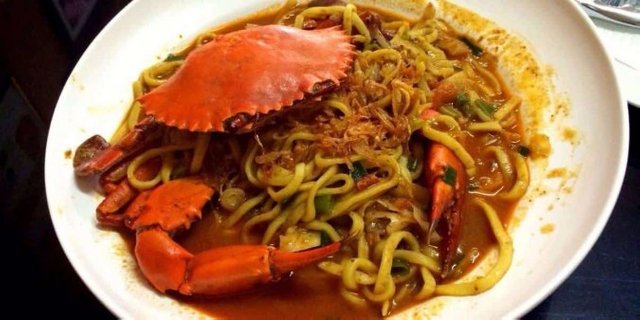
Food
i. Chicken Catch
ii. Nasi Guri
iii. Eungkot Paya
iv. Kuwah Eungkôt Yéë
v. Beulangong Sauce
vi. Kanji Rumbi
vii. Keumamah
viii.Kuwah Pliëk U
ix. Martabak Aceh
x. Masam Keu'euëng
xi. Aceh noodle
xii. Udeuëng Acid Sauce
xiii. Satay Mature
xiv. Sie Reuboh
xv. Mie Caluk
xvi.Sop Marrow
xvii. etc
Snack
i. Timphan
ii. Truth
iii. Meuseukat
iv. Kanji Rumbi
v. Pulot
vi. Rujak Aceh
vii. Adèe
d. character or hero
1. Sultan Iskandar Muda, the greatest sultan of Aceh
2. Teungku Chik Di Tiro, the great mujahid reviving Aceh's struggle against the Dutch
3. Tuanku Hasyim Banta Muda, the great commander of Aceh's army against the Dutch
4. Teuku Umar, a hero against the Dutch
5. Cut Nyak Dhien, the heroine against the Dutch
6. Cut Nyak Meutia, the heroine against the Dutch
7. Teungku Fakinah, female cleric and Aceh hero against the Dutch
8. Daud Beureu'eh, leader of DI / TII Aceh movement
9. Teuku Mohammad Hasan, the first governor of Sumatra
10. Teuku Nyak Arief, the first governor of Aceh
11. Hasan Tiro, founder of the Free Aceh Movement
12. Ismail al-Asyi, the great ulema of Aceh
13. Teuku Jacob, the father of Indonesian paleoanthropology
14. Teuku Markam, freedom fighters, entrepreneurs and contributors 38 kg of gold Monas
15. Ibrahim Alfian, historian and former dean of the Faculty of Letters, UGM
16. P. Ramlee, the legendary Malaysian artist
17. Tan Sri Sanusi Juned, former Malaysian minister
18. and etc.
that just a litle bit of acehnese, if you wanna read or see more click down here, this is the soure and i just quote and change to english.
the source is here : https://id.wikipedia.org/wiki/Suku_Aceh
for the pict i just put in : google image
